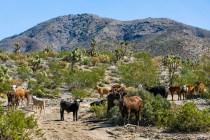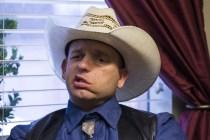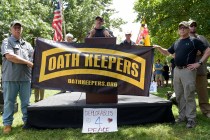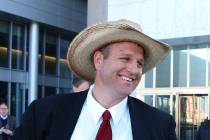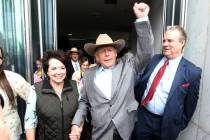BLM’s next move against Bundy not a matter of if, but when, former officials say
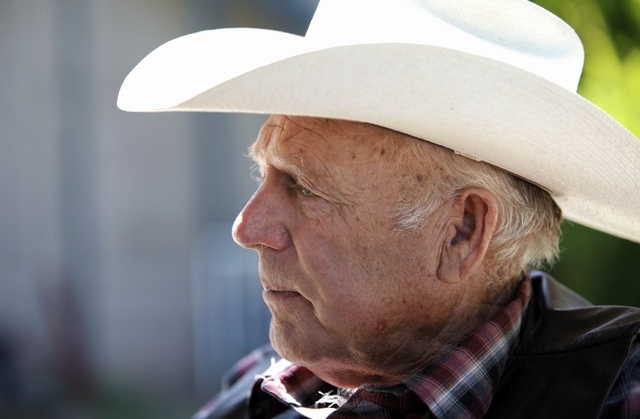
Despite all the resources spent and all the ink and airtime spilled over Cliven Bundy’s cattle, government officials find themselves right back where they started. Hundreds of cows still roam on public land closed to grazing 16 years ago, while Bundy remains free to defy federal authority as his unpaid fees pile up.
So what does the Bureau of Land Management do now?
Agency officials have had little to say about that since April 12, when they hastily ended their roundup and backed away from an armed confrontation with Bundy supporters, allowing the rancher to ride in and free his cattle from federal custody.
The BLM’s message, repeated word for word by different agency representatives over the past month: “We will continue to pursue this matter administratively and judicially.”
The first hint of what that might mean came late last week, when Clark County Sheriff Doug Gillespie confirmed the launch of an FBI criminal investigation into threats made against law enforcement officers during the armed confrontation.
But how might the government solve its original problem of rogue cattle on federal ground?
Retired National Park Service official Alan O’Neill expects the next move to come from one of two places: the Justice Department or U.S. District Judge Larry Hicks, author of the October court order that gave Bundy 45 days to remove his cattle or risk losing them to the government. Hicks also ordered the rancher not to “physically interfere with any seizure or impoundment operation.”
“Obviously Bundy is in contempt of court,” O’Neill said. “In my opinion he ought to be held accountable.”
One way that might happen is for the government to target more Bundy family property — their land and even their home instead of just their cattle — as the government looks to recover roughly $1.1 million in unpaid fees and penalties it says the rancher owes.
“If Bundy is allowed to escape this without consequences, that just sends a really bad message that federal law is optional as long as you have enough men with guns to back you up,” O’Neill said.
‘LESSONS TO BE LEARNED’
Former BLM Director Bob Abbey said he doesn’t know what the agency has planned — and he stressed that none of his former colleagues has asked for his input — but like O’Neill he thinks the next chapter is likely to unfold in a courtroom far from the open range.
Abbey said nothing can really be done about Bundy’s cattle, at least on the ground, for the next four months or so.
“You don’t want to be removing livestock in the middle of summer,” he explained, because it’s hard on the animals and it’s hard on the people doing the work.
Waiting could have other benefits. Abbey said a break in the action during the hottest part of the year might allow enough time for some of Bundy’s militia friends to disperse and the situation in Bunkerville to cool down.
Abbey was at the helm of the BLM in 2012, the last time the agency mobilized to impound Bundy’s cattle only to call the operation off just before it began. Contrary to some reports, he said the 2012 operation was not canceled because of safety concerns or threats made against government employees.
The problem two years ago came down to poor planning and communication. Abbey said the operation was rushed and BLM leaders in Washington, D.C., were brought in too late. With less than 24 hours before the roundup was to start, those in charge had second thoughts about using a court order issued in 1998 to impound cattle 14 years later.
Abbey said they decided they could “bring more legitimacy” to the action if they went back to court to “refresh that court order.”
At the risk of playing “Monday morning quarterback,” he said there were a few things about the BLM’s most recent roundup he would have done differently.
“No doubt there’s lessons to be learned here,” he said. “My concern is that there was an appearance of an aggressive posture on the part of the Bureau of Land Management.”
Though the BLM needed to have additional law enforcement officers on call or even staged nearby given the potential for unrest, Abbey said allowing them to lead the way may have “encouraged confrontation rather than discouraged confrontation.”
He also questioned the decision to close off so much land and set up two small so-called “First Amendment areas” in an attempt to keep protesters away from the roundup. The pens went unused and were eventually taken down, but not before becoming a flash point for criticism of the government.
“I can see why you’d want to keep people from interfering with that kind of operation,” said Abbey, now a partner in a Las Vegas-based consulting firm, “but that doesn’t necessarily mean you have to close off 600,000 acres of land.”
Before he was called to head the BLM, he was state director for the agency in Nevada from 1997 to 2005.
During that time, the office dealt with several grazing trespassers on federal land and ultimately rounded up livestock in Nye, Eureka and Elko counties. Abbey said Bundy “was on our list” back then, but those other cases were a higher priority.
O’Neill has his own history with Clark County’s most well-known rancher.
In 1996, in the midst of O’Neill’s 13-year stint as superintendent for Lake Mead National Recreation Area, the National Park Service made plans to remove cattle roaming illegally at the northern end of the park. He said the operation was called off at the last minute amid veiled threats similar to those made against government workers last month.
“We were ready to go. The U.S. attorney’s office told us to back off. We backed off.”
STILL COMMITTED TO THE CAUSE
Such stories are nothing new in Nevada, according to Paul Starrs, professor of geography at the University of Nevada, Reno. Battles over who should control vast stretches of public land across the West have boiled up once a generation or so since just before the Civil War.
“This is a return of a story that has had many faces through time,” Starrs said.
If history is any indication, Bundy shouldn’t count on the federal government to drop the matter.
“If you owed a million dollars to the Internal Revenue Service, do you think they would show you any mercy?” Starrs asked.
Bundy is unlikely to find so many people standing at his side the next time the government comes for his cattle. Many of the politicians and prominent media personalities who initially supported him quickly turned their backs after he made racist remarks at a pair of his own news conferences last month. Weeks later, the 68-year-old rancher’s controversial comments continue to reverberate across the nation. President Barack Obama and comedian Joel McHale mocked Bundy during the annual White House Correspondents’ Dinner on May 3.
But it appears some supporters will stick by the Bundys no matter what. Evidence of that can be found in the diminished but fervent group of militia members that has camped around the ranch for the past month.
Abbey said the Bundys seem to have tapped into the frustration felt by a growing number of people who feel disenfranchised by the federal government.
“The number of people we saw come armed — and, more importantly, willing to use those arms against the government — is a frightening situation,” he said.
“Believe me, they have a network,” O’Neill said. “We ran into it in ’96, and it’s worse now.”
For that reason alone, he expects federal authorities to proceed with patience and care.
“I don’t think the government is going to be going in and doing (another) gather anytime soon. You don’t want to do anything that encourages the militias to stay around,” he said. “But you can’t let it go. The government can’t turn their backs on this. Although this is a local situation, this obviously has national ramifications, certainly in the West.”
Abbey agreed.
“The livestock will eventually be removed. It’s a question of who will remove them,” he said. “I would hope that Mr. Bundy would do some things differently, just as I would hope the BLM would do some things differently.”
Contact Henry Brean at hbrean@reviewjournal.com or 702-383-0350. Find him on Twitter: @RefriedBrean.











